

Dietary Recommendations for Bariatric Patients to Prevent Kidney Stone Formation. Calcium absorption predominantly occurs in the duodenum and proximal jejunum and is dependent on vitamin D levels.
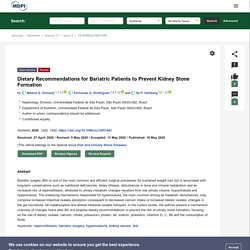
Due to fat malabsorption, all fat-soluble vitamins (A, D, E and K) are at risk of deficiency among bariatric patients. Some investigators pointed out a deficient calcium intake and vitamin D deficiency after RYGB [60]. Schafer et al. [61] demonstrated that even patients with acceptable levels of vitamin D (≥ 30 ng/mL) and maintained under an adequate calcium intake (> 1200 mg/day) had a marked decrease in intestinal calcium absorption from 33% preoperatively to 7% after 6 months of RYGB. Risk of Kidney Stones: Influence of Dietary Factors, Dietary Patterns, and Vegetarian–Vegan Diets.
1.
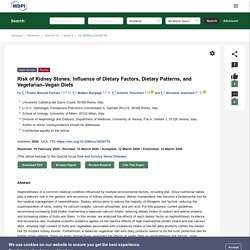
Introduction Nephrolithiasis is known to be a medical condition characterized by high prevalence all over the world [1,2,3]. Water for preventing urinary stones - Bao, Y - 2020. Which Diet for Calcium Stone Patients: A Real-World Approach to Preventive Care. 1.
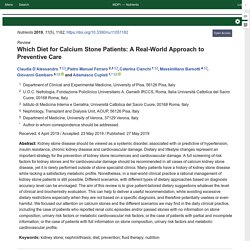
Background Kidney stone disease is quite prevalent in western countries: in the United States, its prevalence in a representative sample of the general population reaches 9% [1] and similar figures have been reported in European populations [2]. It shows also a high recurrence rate, namely 30% to 50% at 5-years [3,4]. Therefore, primary and secondary prevention of urinary tract stone disease is an important medical task. A history of kidney stones is also associated with a higher prevalence of chronic kidney disease and cardiovascular damage or events when compared with non–stone formers [5,6,7,8]. The association between kidney stones and metabolic syndrome and/or cardiovascular disease should prompt physicians to consider the assessment of the cardiovascular risk factors in any adult with kidney stones. Dietary and lifestyle changes are a major strategy for the prevention of kidney stone recurrences.
Table 1. Unfortunately, this rarely occurs in the daily clinical practice. 2. Renal and ureteric stones: assessment and management. This guideline covers assessing and managing renal and ureteric stones.

It aims to improve the detection, clearance and prevention of stones, so reducing pain and anxiety, and improving quality of life. It does not cover the infected obstructed kidney, which needs urgent drainage. Medical therapy for nephrolithiasis: State of the art. P.M.
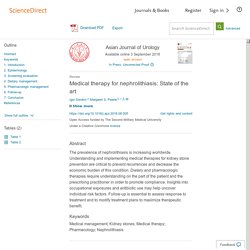
Ferraro, E.N. Taylor, G. Gambaro, G.C. Protective roles of flavonoids and flavonoid-rich plant extracts against urolithiasis: A review: Critical Reviews in Food Science and Nutrition: Vol 0, No 0. Updates in the Metabolic Management of Calcium Stones. Vitamin D, Hypercalciuria and Kidney Stones. Alexander Randall described, in 1936, that calcium phosphate deposits at the tip of renal papillae, the Randall’s plaques, were at the origin of kidney stones in around 20% of kidneys [7].
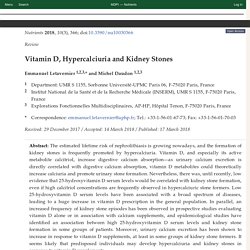
Several authors found a similar occurrence of calcium phosphate deposits in Caucasians from various countries [72,73]. These plaques form in the interstitial tissue, spread and break the urothelium at later stages, promoting heterogeneous nucleation of calcium oxalate crystals and calcium oxalate stone formation. Effectiveness of Treatment Modalities on Kidney Stone Recurrence.
Anna L.
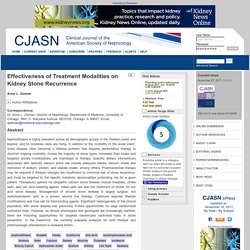
Zisman + Author Affiliations. Epidemiology, pathophysiology, and management of uric acid urolithiasis: A narrative review - ScienceDirect. Nephrolithiasis and Gastrointestinal Tract Diseases. Kidney Stones After Bariatric Surgery: Risk Assessment and Mitigation. This site uses cookies to improve performance.

If your browser does not accept cookies, you cannot view this site. Setting Your Browser to Accept Cookies There are many reasons why a cookie could not be set correctly. Effects of non-pharmacological interventions on urinary citrate levels: a systematic review and meta-analysis. Skip to Main Content Sign In Register Advanced Search Online ISSN 1460-2385 Print ISSN 0931-0509 Copyright © 2017 European Renal Association - European Dialysis and Transplant Association Connect.
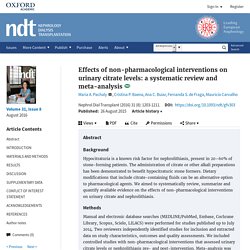
Medical and alternative therapies in urinary tract stone disease. Nephrolithiasis is a widespread medical problem, with an increased incidence in the last 20 years[1-4].

Its prevalence is expected to rise in the upcoming decades, as has been the case for obesity, diabetes, and metabolic syndrome[2,3]. Another problem related to nephrolithiasis is recurrence. Update on Nephrolithiasis: Core Curriculum 2016. There are 2 main sources of urinary oxalate in humans: endogenous oxalate production and exogenous oxalate absorption. The kidney is responsible for oxalate excretion. Oxalate enters the proximal tubule through filtration and secretion. Hyperoxaluria is present in 10% to 50% of calcium stone formers and defined as urinary oxalate excretion > 40 mg/d. Elevated urinary oxalate excretion increases supersaturation, risk for crystal formation, and tubular damage.
Primary hyperoxalurias are autosomal recessive disorders that lead to oxalate overproduction in the liver secondary to defects in glyoxylate metabolism. In addition to endogenous oxalate production, dietary oxalate is absorbed by passive and paracellular transport across the tight junctions of the intestine, mainly in the colon. Medical Management to Prevent Recurrent Nephrolithiasis in Adults: A Systematic Review for an American College of Physicians Clinical Guideline. From Minneapolis Veterans Affairs Medical Center, Minnesota Evidence-based Practice Center, University of Minnesota, and Hennepin County Medical Center, Minneapolis, Minnesota; John H. Stroger Jr. Hospital of Cook County, Chicago, Illinois; and Cleveland Clinic Lerner College of Medicine of Case Western Reserve University, Cleveland, Ohio.
Disclaimer: This report is based on research conducted by the Minnesota Evidence-based Practice Center under contract to AHRQ, Rockville, Maryland. The findings and conclusions in this document are those of the authors, who are responsible for its content, and do not necessarily represent the views of AHRQ. No statement in this report should be construed as an official position of AHRQ, the U.S. Acknowledgment: The authors thank Marilyn Eells and Maureen Carlyle for technical editing support. Grant Support: By contract HHSA 290 2007 10064 1 from AHRQ to the Minnesota Evidence-based Practice Center. Potential Conflicts of Interest: Dr. Dr. Dr. Dr. Drs. Dietary and Pharmacologic Management to Prevent Recurrent Nephrolithiasis in Adults: A Clinical Practice Guideline From the American College of PhysiciansDietary and Pharmacologic Management to Prevent Recurrent Nephrolithiasis. From the American College of Physicians and University of Pennsylvania Health System, Philadelphia, Pennsylvania, and Virginia Tech Carilion School of Medicine and Carilion Clinic, Roanoke, Virginia.
Note: Clinical practice guidelines are “guides” only and may not apply to all patients and all clinical situations. Thus, they are not intended to override clinicians’ judgment. All ACP clinical practice guidelines are considered automatically withdrawn or invalid 5 years after publication, or once an update has been issued. Disclaimer: The authors of this article are responsible for its contents, including any clinical or treatment recommendations. Financial Support: Financial support for the development of this guideline comes exclusively from the ACP operating budget.